Home / Chiral Allenes And Chiral Axes
Stereochemistry and Chirality
Chiral Allenes And Chiral Axes
Last updated: June 11th, 2025 |
All About Allenes, Chiral and Otherwise
- Allenes are examples of cumulated dienes, molecules with consecutive (not conjugated) double bonds.
- Allenes are not flat. Due to the fact that the two pi-bonds of allene are at right angles to each other, the end substituents are also turned 90° as well.
- Allene itself has two mirror planes and is achiral.
- However, if both ends of the allene are each attached to two different substituents, the resulting molecule lacks a plane of symmetry and is chiral.
- This type of chirality is referred to as “axial chirality” because it resembles the handedness of screws.

Table of Contents
- Allenes are “Cumulated” Dienes
- The Central Carbon In Allene Is sp Hybridized
- A 3-D “Fly-By” Of Allene Shows It Is Not Flat
- Examples of Substituted Allenes With Mirror Planes
- An Example of A Chiral, Di-Substituted Allene
- Chiral Allenes Have an “Axis of Chirality”
- Summary: How Do I Recognize A Chiral Allene vs. An Achiral Allene?
- Notes
1. Allenes are “Cumulated” Dienes
We’ve met alkenes before – right? Just in case you haven’t, let’s review the basics, because today’s post is going to depend on understanding a few of the most important concepts.
Alkenes contain both sigma [ σ] bonding formed through “head-on” orbital overlap [i.e. “single bonds”] and also pi [ π ] bonding where orbitals have “side-on” overlap [i.e. “multiple bonds”]

Alkenes like ethylene are flat [planar]. The p orbitals are at 90 degrees to this planar structure.
If you’ve ever used graphite lubricant, you might know it’s slippery because graphite is made up of layered sheets of flat, pi-bonded carbon, and the sheets have very little friction between each layer. Graphene is the same idea, only it’s a single layer.
Now let’s draw something weird. What do we get when we extend a second double bond directly adjacent to the first one?

Does this look strange to you? The first time you see this, you’ll probably think – yes! You might wonder – do these even exist? The answer is also – Yes! This moleule is called allene, and is part of a family of molecules called cumulenes, so named because the double bonds are cumulative (consecutive).
2. The Central Carbon In Allene Is sp Hybridized
Now let’s ask: what might the bonding in this molecule look like? In other words, what does it look like in 3D?
You might think – simple! It’s flat, like an alkene!
It’s actually not quite that simple! The key is that central carbon – it has TWO π bonds.
You might recall that acetylene has two π bonds as well, at 90 degrees to each other.

The same is true for allene, except that it’s only the central carbon that is involved in two pi bonds.
Here’s what the orbitals of this molecule look like.
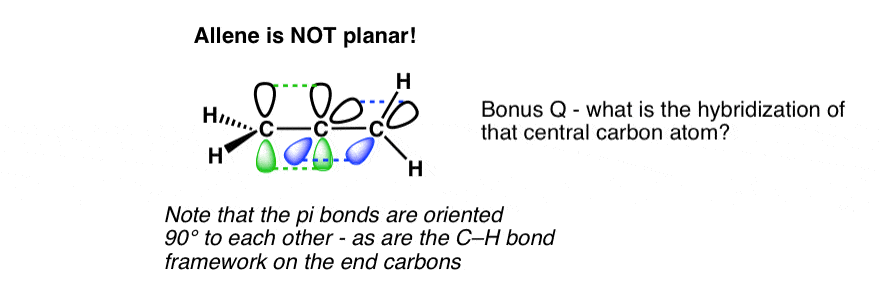
The hybridization of that central carbon? It’s sp, just like the carbons in acetylene. The end carbons are sp2
3. A 3-D “Fly-by” Shows That Allene Is Not Flat
The line diagram of allene really does not do it justice.
So here I present a 3D “fly-by” of allene. Note how the two CH2 groups are “offset” with respect to each other by 90 degrees.
Allene is not flat! [those white balls – imagine they are hydrogen]
4. Substituted Allenes That Have Mirror Planes
Like so many things in organic chemistry, this simple fact leads to consequences that aren’t immediately apparent. Let’s pay attention to the mirror planes in this molecule. Note that there are two.
Recall that in order for a molecule to be chiral it must not be superimposable on its mirror image. If the molecule has a mirror plane (plane of symmetry) then it will be superimposable on its mirror image [and therefore achiral].
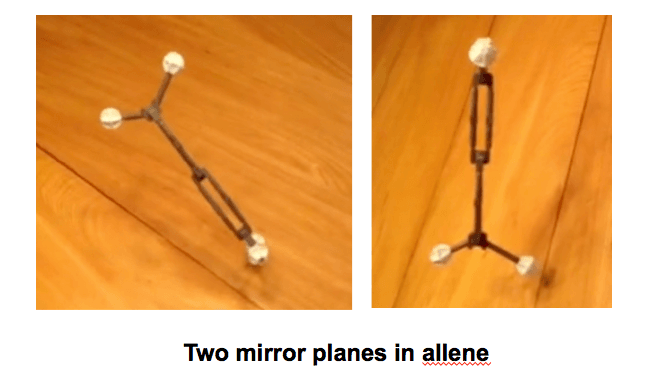
With two mirror planes this is definitely an achiral molecule.
Now let’s start playing around a bit. What happens if we replace one of the hydrogens by another group? In the drawing I’ve arbitrarily made this atom Cl but in practice it can be anything except H in this case.
Here’s a line drawing of the molecule and a picture of its orbitals.

Now here’s what it looks like in 3D. Notice that we’ve lost one of the mirror planes! But it still has one, so it’s still achiral.
Now: what happens if we add a second group to the same carbon?

It’s still achiral! – in fact, we’ve gone back to having two mirror planes.
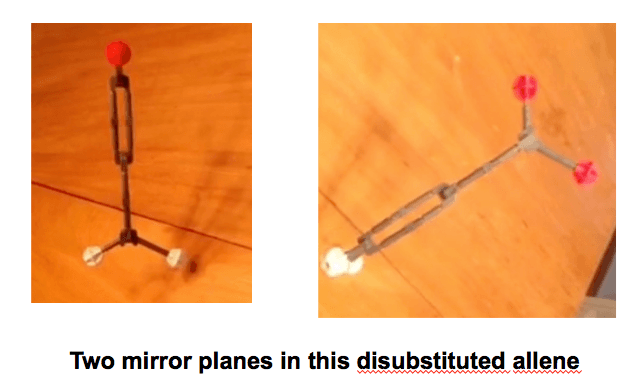
5. This Di-Substituted Allene Has No Mirror Plane – And is Therefore Chiral!
Now, finally, let’s change the position of that second group. Instead of making it so that there are two identical groups on the carbon, let’s change it so that there’s one on each carbon. Like this:

Here’s the 3D version.
Now I ask: where are the mirror planes?
THERE ARE NONE! If there are no mirror planes —> then we are looking at a chiral molecule.
6. Chiral Allenes Have An “Axis Of Chirality”
Wait. You might ask -what trickery is this? We have no chiral centres. Don’t we need something to have a chiral centre to be chiral?
Actually you are very familiar with a chiral object that has no chiral centre.
Have you ever screwed before?
No, no, no! I mean, screwed using a screwdriver. This is a chemistry blog. Don’t expect anything lascivious here.
See, most screw threads are, to use a familiar mnemonic, “righty tighty, lefty loosey.” You have to turn the screwdriver clockwise to screw it in, and counterclockwise to loosen. Screws are chiral!
[By the way the enantiomer of that common screw thread would be… “lefty tighty, righty loosey” – those types of threads exist BTW – especially in gas barbecues, so as to prevent people from trying to connect things to them such as garden hoses or other idiotic things].
Here’s a representative picture of two chiral screws. You can also imagine these as spiral staircases. Imagine walking up each staircase. On the staircase labelled “left- hand” below, your right arm would be on the inside as you ascend. On the “right-hand” staircase, your left arm would be on the inside as you ascend. [see Note 2]

Instead of having a chiral centre, screws have what we refer to as a “chiral axis“. Other common examples of things with chiral axes: spiral staircases, snail shells and DNA.
Our disubstituted allene has a chiral axis – just like a screw.
Screws are chiral – and chiral objects have enantiomers. And just as screws have enantiomers, so do chiral molecules with a chiral axis.
What would the enantiomer of the allene look like?
Here is an enantiomeric pair of allenes. Can you see now how they are not superimposable?
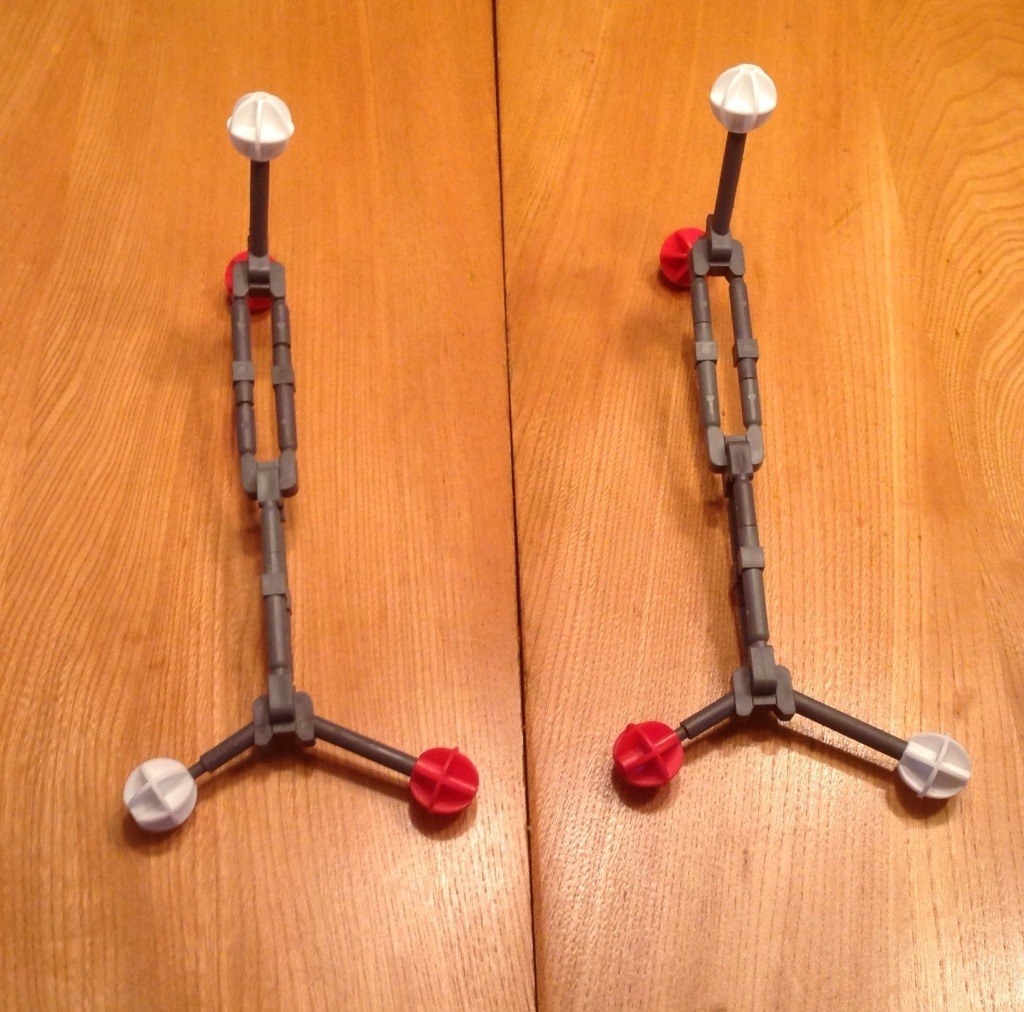
7. Summary: How Do You Recognize A Chiral Allene As Opposed To An Achiral Allene?
[In other words, an allene with a chiral axis vs. an allene without a chiral axis]
You might ask, is there some kind of short cut for recognizing a chiral allene? Sure.
Examine both “ends” of the allene. If either of those ends is attached to two identical substituents, it is achiral – because it will have a mirror plane.
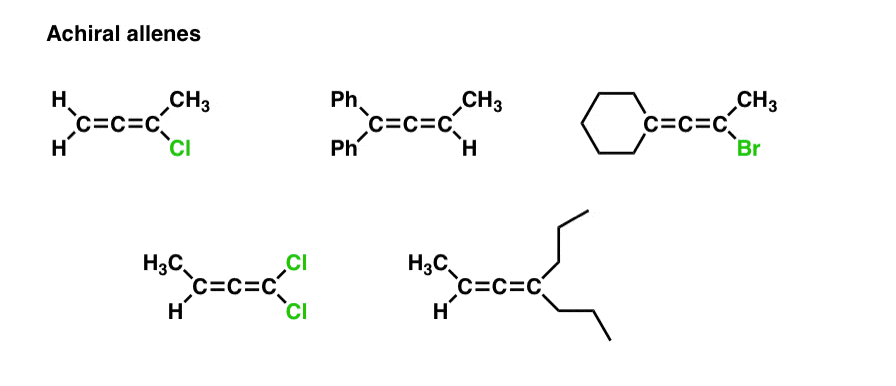
If neither of the ends are attached to two identical substituents, then it is chiral.
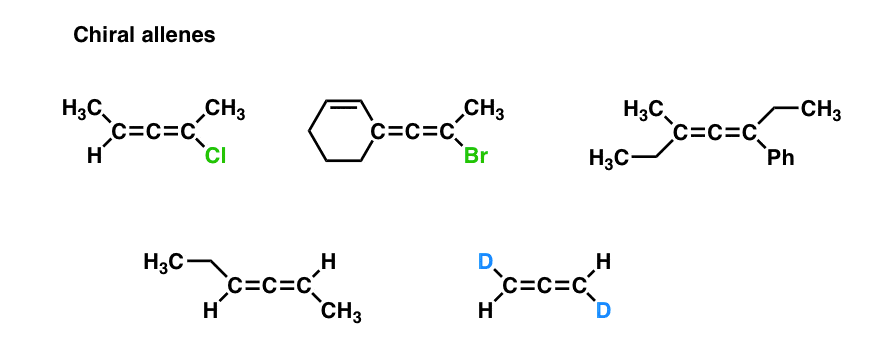
Notes
Related Articles
- Optical Purity and Enantiomeric Excess
- Bonding And Antibonding Pi Orbitals
- Conjugation And Resonance In Organic Chemistry
- Enantiomers vs Diastereomers vs The Same? Two Methods For Solving Problems
- What’s a Racemic Mixture?
- Types of Isomers: Constitutional Isomers, Stereoisomers, Enantiomers, and Diastereomers
- Stereochemistry Practice Problems and Quizzes (MOC Membership)
Note 1. Bonus question: Would you expect this molecule to be chiral? Why or why not?
 Click to Flip
Click to Flip
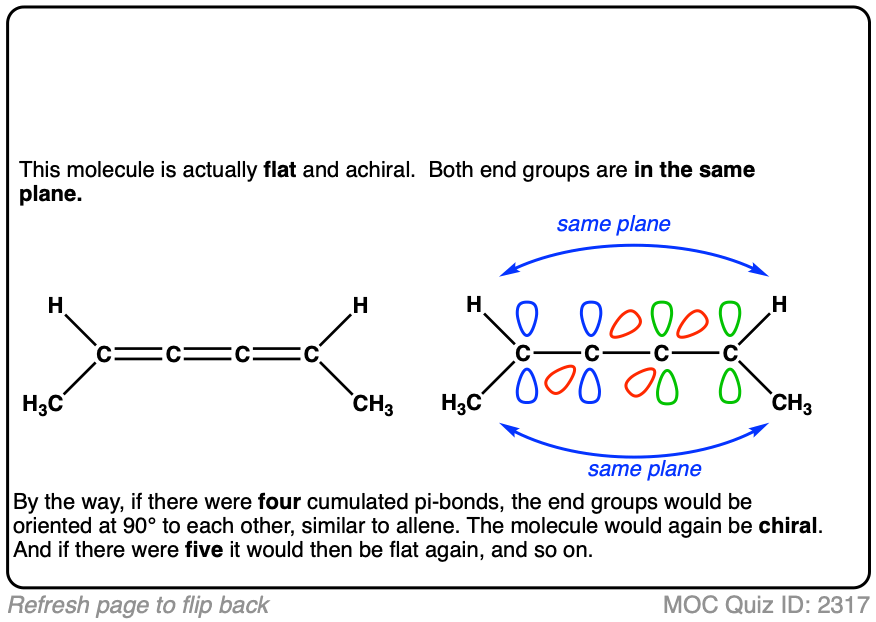
Note 2. Nerdy note about staircases, possibly a myth. This may or may not be true, but I recall reading a book in my childhood about castles where it was said that castles were built with staircases that forced someone ascending them [an attacker, presumably] to have their right (sword) hand on the inside and a descending defender to have their sword hand on the outside. The idea being that there is much more freedom of motion if your sword hand is on the outside because you have to swing it across your body.
Note 3. Recall that free rotation about the C-C pi bond in alkenes is not possible without breaking the C-C pi bond. This requires about 62 kcal/mol in energy (for trans-2-butene). What about allenes? Considerably less energy is required – about 46 kcal/mol for the allene below. Still, this requires heating the molecule at about 260°C to get any meaningful rate of isomerization.

00 General Chemistry Review
01 Bonding, Structure, and Resonance
- How Do We Know Methane (CH4) Is Tetrahedral?
- Hybrid Orbitals and Hybridization
- How To Determine Hybridization: A Shortcut
- Orbital Hybridization And Bond Strengths
- Sigma bonds come in six varieties: Pi bonds come in one
- A Key Skill: How to Calculate Formal Charge
- The Four Intermolecular Forces and How They Affect Boiling Points
- 3 Trends That Affect Boiling Points
- How To Use Electronegativity To Determine Electron Density (and why NOT to trust formal charge)
- Introduction to Resonance
- How To Use Curved Arrows To Interchange Resonance Forms
- Evaluating Resonance Forms (1) - The Rule of Least Charges
- How To Find The Best Resonance Structure By Applying Electronegativity
- Evaluating Resonance Structures With Negative Charges
- Evaluating Resonance Structures With Positive Charge
- Exploring Resonance: Pi-Donation
- Exploring Resonance: Pi-acceptors
- In Summary: Evaluating Resonance Structures
- Drawing Resonance Structures: 3 Common Mistakes To Avoid
- How to apply electronegativity and resonance to understand reactivity
- Bond Hybridization Practice
- Structure and Bonding Practice Quizzes
- Resonance Structures Practice
02 Acid Base Reactions
- Introduction to Acid-Base Reactions
- Acid Base Reactions In Organic Chemistry
- The Stronger The Acid, The Weaker The Conjugate Base
- Walkthrough of Acid-Base Reactions (3) - Acidity Trends
- Five Key Factors That Influence Acidity
- Acid-Base Reactions: Introducing Ka and pKa
- How to Use a pKa Table
- The pKa Table Is Your Friend
- A Handy Rule of Thumb for Acid-Base Reactions
- Acid Base Reactions Are Fast
- pKa Values Span 60 Orders Of Magnitude
- How Protonation and Deprotonation Affect Reactivity
- Acid Base Practice Problems
03 Alkanes and Nomenclature
- Meet the (Most Important) Functional Groups
- Condensed Formulas: Deciphering What the Brackets Mean
- Hidden Hydrogens, Hidden Lone Pairs, Hidden Counterions
- Don't Be Futyl, Learn The Butyls
- Primary, Secondary, Tertiary, Quaternary In Organic Chemistry
- Branching, and Its Affect On Melting and Boiling Points
- The Many, Many Ways of Drawing Butane
- Wedge And Dash Convention For Tetrahedral Carbon
- Common Mistakes in Organic Chemistry: Pentavalent Carbon
- Table of Functional Group Priorities for Nomenclature
- Summary Sheet - Alkane Nomenclature
- Organic Chemistry IUPAC Nomenclature Demystified With A Simple Puzzle Piece Approach
- Boiling Point Quizzes
- Organic Chemistry Nomenclature Quizzes
04 Conformations and Cycloalkanes
- Staggered vs Eclipsed Conformations of Ethane
- Conformational Isomers of Propane
- Newman Projection of Butane (and Gauche Conformation)
- Introduction to Cycloalkanes
- Geometric Isomers In Small Rings: Cis And Trans Cycloalkanes
- Calculation of Ring Strain In Cycloalkanes
- Cycloalkanes - Ring Strain In Cyclopropane And Cyclobutane
- Cyclohexane Conformations
- Cyclohexane Chair Conformation: An Aerial Tour
- How To Draw The Cyclohexane Chair Conformation
- The Cyclohexane Chair Flip
- The Cyclohexane Chair Flip - Energy Diagram
- Substituted Cyclohexanes - Axial vs Equatorial
- Ranking The Bulkiness Of Substituents On Cyclohexanes: "A-Values"
- Cyclohexane Chair Conformation Stability: Which One Is Lower Energy?
- Fused Rings - Cis-Decalin and Trans-Decalin
- Naming Bicyclic Compounds - Fused, Bridged, and Spiro
- Bredt's Rule (And Summary of Cycloalkanes)
- Newman Projection Practice
- Cycloalkanes Practice Problems
05 A Primer On Organic Reactions
- The Most Important Question To Ask When Learning a New Reaction
- Curved Arrows (for reactions)
- Nucleophiles and Electrophiles
- The Three Classes of Nucleophiles
- Nucleophilicity vs. Basicity
- What Makes A Good Nucleophile?
- What Makes A Good Leaving Group?
- 3 Factors That Stabilize Carbocations
- Equilibrium and Energy Relationships
- 7 Factors that stabilize negative charge in organic chemistry
- 7 Factors That Stabilize Positive Charge in Organic Chemistry
- What's a Transition State?
- Hammond's Postulate
- Learning Organic Chemistry Reactions: A Checklist (PDF)
- Introduction to Oxidative Cleavage Reactions
06 Free Radical Reactions
- Free Radical Reactions
- 3 Factors That Stabilize Free Radicals
- Bond Strengths And Radical Stability
- Free Radical Initiation: Why Is "Light" Or "Heat" Required?
- Initiation, Propagation, Termination
- Monochlorination Products Of Propane, Pentane, And Other Alkanes
- Selectivity In Free Radical Reactions
- Selectivity in Free Radical Reactions: Bromination vs. Chlorination
- Halogenation At Tiffany's
- Allylic Bromination
- Bonus Topic: Allylic Rearrangements
- In Summary: Free Radicals
- Synthesis (2) - Reactions of Alkanes
- Free Radicals Practice Quizzes
07 Stereochemistry and Chirality
- Types of Isomers: Constitutional Isomers, Stereoisomers, Enantiomers, and Diastereomers
- How To Draw The Enantiomer Of A Chiral Molecule
- How To Draw A Bond Rotation
- Introduction to Assigning (R) and (S): The Cahn-Ingold-Prelog Rules
- Assigning Cahn-Ingold-Prelog (CIP) Priorities (2) - The Method of Dots
- Enantiomers vs Diastereomers vs The Same? Two Methods For Solving Problems
- Assigning R/S To Newman Projections (And Converting Newman To Line Diagrams)
- How To Determine R and S Configurations On A Fischer Projection
- The Meso Trap
- Optical Rotation, Optical Activity, and Specific Rotation
- Optical Purity and Enantiomeric Excess
- What's a Racemic Mixture?
- Chiral Allenes And Chiral Axes
- Stereochemistry Practice Problems and Quizzes
08 Substitution Reactions
- Nucleophilic Substitution Reactions - Introduction
- Two Types of Nucleophilic Substitution Reactions
- The SN2 Mechanism
- Why the SN2 Reaction Is Powerful
- The SN1 Mechanism
- The Conjugate Acid Is A Better Leaving Group
- Comparing the SN1 and SN2 Reactions
- Polar Protic? Polar Aprotic? Nonpolar? All About Solvents
- Steric Hindrance is Like a Fat Goalie
- Common Blind Spot: Intramolecular Reactions
- Substitution Practice - SN1
- Substitution Practice - SN2
09 Elimination Reactions
- Elimination Reactions (1): Introduction And The Key Pattern
- Elimination Reactions (2): The Zaitsev Rule
- Elimination Reactions Are Favored By Heat
- Two Elimination Reaction Patterns
- The E1 Reaction
- The E2 Mechanism
- E1 vs E2: Comparing the E1 and E2 Reactions
- Antiperiplanar Relationships: The E2 Reaction and Cyclohexane Rings
- Bulky Bases in Elimination Reactions
- Comparing the E1 vs SN1 Reactions
- Elimination (E1) Reactions With Rearrangements
- E1cB - Elimination (Unimolecular) Conjugate Base
- Elimination (E1) Practice Problems And Solutions
- Elimination (E2) Practice Problems and Solutions
10 Rearrangements
11 SN1/SN2/E1/E2 Decision
- Identifying Where Substitution and Elimination Reactions Happen
- Deciding SN1/SN2/E1/E2 (1) - The Substrate
- Deciding SN1/SN2/E1/E2 (2) - The Nucleophile/Base
- SN1 vs E1 and SN2 vs E2 : The Temperature
- Deciding SN1/SN2/E1/E2 - The Solvent
- Wrapup: The Key Factors For Determining SN1/SN2/E1/E2
- Alkyl Halide Reaction Map And Summary
- SN1 SN2 E1 E2 Practice Problems
12 Alkene Reactions
- E and Z Notation For Alkenes (+ Cis/Trans)
- Alkene Stability
- Alkene Addition Reactions: "Regioselectivity" and "Stereoselectivity" (Syn/Anti)
- Stereoselective and Stereospecific Reactions
- Hydrohalogenation of Alkenes and Markovnikov's Rule
- Hydration of Alkenes With Aqueous Acid
- Rearrangements in Alkene Addition Reactions
- Halogenation of Alkenes and Halohydrin Formation
- Oxymercuration Demercuration of Alkenes
- Hydroboration Oxidation of Alkenes
- m-CPBA (meta-chloroperoxybenzoic acid)
- OsO4 (Osmium Tetroxide) for Dihydroxylation of Alkenes
- Palladium on Carbon (Pd/C) for Catalytic Hydrogenation of Alkenes
- Cyclopropanation of Alkenes
- A Fourth Alkene Addition Pattern - Free Radical Addition
- Alkene Reactions: Ozonolysis
- Summary: Three Key Families Of Alkene Reaction Mechanisms
- Synthesis (4) - Alkene Reaction Map, Including Alkyl Halide Reactions
- Alkene Reactions Practice Problems
13 Alkyne Reactions
- Acetylides from Alkynes, And Substitution Reactions of Acetylides
- Partial Reduction of Alkynes With Lindlar's Catalyst
- Partial Reduction of Alkynes With Na/NH3 To Obtain Trans Alkenes
- Alkyne Hydroboration With "R2BH"
- Hydration and Oxymercuration of Alkynes
- Hydrohalogenation of Alkynes
- Alkyne Halogenation: Bromination and Chlorination of Alkynes
- Oxidation of Alkynes With O3 and KMnO4
- Alkenes To Alkynes Via Halogenation And Elimination Reactions
- Alkynes Are A Blank Canvas
- Synthesis (5) - Reactions of Alkynes
- Alkyne Reactions Practice Problems With Answers
14 Alcohols, Epoxides and Ethers
- Alcohols - Nomenclature and Properties
- Alcohols Can Act As Acids Or Bases (And Why It Matters)
- Alcohols - Acidity and Basicity
- The Williamson Ether Synthesis
- Ethers From Alkenes, Tertiary Alkyl Halides and Alkoxymercuration
- Alcohols To Ethers via Acid Catalysis
- Cleavage Of Ethers With Acid
- Epoxides - The Outlier Of The Ether Family
- Opening of Epoxides With Acid
- Epoxide Ring Opening With Base
- Making Alkyl Halides From Alcohols
- Tosylates And Mesylates
- PBr3 and SOCl2
- Elimination Reactions of Alcohols
- Elimination of Alcohols To Alkenes With POCl3
- Alcohol Oxidation: "Strong" and "Weak" Oxidants
- Demystifying The Mechanisms of Alcohol Oxidations
- Protecting Groups For Alcohols
- Thiols And Thioethers
- Calculating the oxidation state of a carbon
- Oxidation and Reduction in Organic Chemistry
- Oxidation Ladders
- SOCl2 Mechanism For Alcohols To Alkyl Halides: SN2 versus SNi
- Alcohol Reactions Roadmap (PDF)
- Alcohol Reaction Practice Problems
- Epoxide Reaction Quizzes
- Oxidation and Reduction Practice Quizzes
15 Organometallics
- What's An Organometallic?
- Formation of Grignard and Organolithium Reagents
- Organometallics Are Strong Bases
- Reactions of Grignard Reagents
- Protecting Groups In Grignard Reactions
- Synthesis Problems Involving Grignard Reagents
- Grignard Reactions And Synthesis (2)
- Organocuprates (Gilman Reagents): How They're Made
- Gilman Reagents (Organocuprates): What They're Used For
- The Heck, Suzuki, and Olefin Metathesis Reactions (And Why They Don't Belong In Most Introductory Organic Chemistry Courses)
- Reaction Map: Reactions of Organometallics
- Grignard Practice Problems
16 Spectroscopy
- Degrees of Unsaturation (or IHD, Index of Hydrogen Deficiency)
- Conjugation And Color (+ How Bleach Works)
- Introduction To UV-Vis Spectroscopy
- UV-Vis Spectroscopy: Absorbance of Carbonyls
- UV-Vis Spectroscopy: Practice Questions
- Bond Vibrations, Infrared Spectroscopy, and the "Ball and Spring" Model
- Infrared Spectroscopy: A Quick Primer On Interpreting Spectra
- IR Spectroscopy: 4 Practice Problems
- 1H NMR: How Many Signals?
- Homotopic, Enantiotopic, Diastereotopic
- Diastereotopic Protons in 1H NMR Spectroscopy: Examples
- 13-C NMR - How Many Signals
- Liquid Gold: Pheromones In Doe Urine
- Natural Product Isolation (1) - Extraction
- Natural Product Isolation (2) - Purification Techniques, An Overview
- Structure Determination Case Study: Deer Tarsal Gland Pheromone
17 Dienes and MO Theory
- What To Expect In Organic Chemistry 2
- Are these molecules conjugated?
- Conjugation And Resonance In Organic Chemistry
- Bonding And Antibonding Pi Orbitals
- Molecular Orbitals of The Allyl Cation, Allyl Radical, and Allyl Anion
- Pi Molecular Orbitals of Butadiene
- Reactions of Dienes: 1,2 and 1,4 Addition
- Thermodynamic and Kinetic Products
- More On 1,2 and 1,4 Additions To Dienes
- s-cis and s-trans
- The Diels-Alder Reaction
- Cyclic Dienes and Dienophiles in the Diels-Alder Reaction
- Stereochemistry of the Diels-Alder Reaction
- Exo vs Endo Products In The Diels Alder: How To Tell Them Apart
- HOMO and LUMO In the Diels Alder Reaction
- Why Are Endo vs Exo Products Favored in the Diels-Alder Reaction?
- Diels-Alder Reaction: Kinetic and Thermodynamic Control
- The Retro Diels-Alder Reaction
- The Intramolecular Diels Alder Reaction
- Regiochemistry In The Diels-Alder Reaction
- The Cope and Claisen Rearrangements
- Electrocyclic Reactions
- Electrocyclic Ring Opening And Closure (2) - Six (or Eight) Pi Electrons
- Diels Alder Practice Problems
- Molecular Orbital Theory Practice
18 Aromaticity
- Introduction To Aromaticity
- Rules For Aromaticity
- Huckel's Rule: What Does 4n+2 Mean?
- Aromatic, Non-Aromatic, or Antiaromatic? Some Practice Problems
- Antiaromatic Compounds and Antiaromaticity
- The Pi Molecular Orbitals of Benzene
- The Pi Molecular Orbitals of Cyclobutadiene
- Frost Circles
- Aromaticity Practice Quizzes
19 Reactions of Aromatic Molecules
- Electrophilic Aromatic Substitution: Introduction
- Activating and Deactivating Groups In Electrophilic Aromatic Substitution
- Electrophilic Aromatic Substitution - The Mechanism
- Ortho-, Para- and Meta- Directors in Electrophilic Aromatic Substitution
- Understanding Ortho, Para, and Meta Directors
- Why are halogens ortho- para- directors?
- Disubstituted Benzenes: The Strongest Electron-Donor "Wins"
- Electrophilic Aromatic Substitutions (1) - Halogenation of Benzene
- Electrophilic Aromatic Substitutions (2) - Nitration and Sulfonation
- EAS Reactions (3) - Friedel-Crafts Acylation and Friedel-Crafts Alkylation
- Intramolecular Friedel-Crafts Reactions
- Nucleophilic Aromatic Substitution (NAS)
- Nucleophilic Aromatic Substitution (2) - The Benzyne Mechanism
- Reactions on the "Benzylic" Carbon: Bromination And Oxidation
- The Wolff-Kishner, Clemmensen, And Other Carbonyl Reductions
- More Reactions on the Aromatic Sidechain: Reduction of Nitro Groups and the Baeyer Villiger
- Aromatic Synthesis (1) - "Order Of Operations"
- Synthesis of Benzene Derivatives (2) - Polarity Reversal
- Aromatic Synthesis (3) - Sulfonyl Blocking Groups
- Birch Reduction
- Synthesis (7): Reaction Map of Benzene and Related Aromatic Compounds
- Aromatic Reactions and Synthesis Practice
- Electrophilic Aromatic Substitution Practice Problems
20 Aldehydes and Ketones
- What's The Alpha Carbon In Carbonyl Compounds?
- Nucleophilic Addition To Carbonyls
- Aldehydes and Ketones: 14 Reactions With The Same Mechanism
- Sodium Borohydride (NaBH4) Reduction of Aldehydes and Ketones
- Grignard Reagents For Addition To Aldehydes and Ketones
- Wittig Reaction
- Hydrates, Hemiacetals, and Acetals
- Imines - Properties, Formation, Reactions, and Mechanisms
- All About Enamines
- Breaking Down Carbonyl Reaction Mechanisms: Reactions of Anionic Nucleophiles (Part 2)
- Aldehydes Ketones Reaction Practice
21 Carboxylic Acid Derivatives
- Nucleophilic Acyl Substitution (With Negatively Charged Nucleophiles)
- Addition-Elimination Mechanisms With Neutral Nucleophiles (Including Acid Catalysis)
- Basic Hydrolysis of Esters - Saponification
- Transesterification
- Proton Transfer
- Fischer Esterification - Carboxylic Acid to Ester Under Acidic Conditions
- Lithium Aluminum Hydride (LiAlH4) For Reduction of Carboxylic Acid Derivatives
- LiAlH[Ot-Bu]3 For The Reduction of Acid Halides To Aldehydes
- Di-isobutyl Aluminum Hydride (DIBAL) For The Partial Reduction of Esters and Nitriles
- Amide Hydrolysis
- Thionyl Chloride (SOCl2) And Conversion of Carboxylic Acids to Acid Halides
- Diazomethane (CH2N2)
- Carbonyl Chemistry: Learn Six Mechanisms For the Price Of One
- Making Music With Mechanisms (PADPED)
- Carboxylic Acid Derivatives Practice Questions
22 Enols and Enolates
- Keto-Enol Tautomerism
- Enolates - Formation, Stability, and Simple Reactions
- Kinetic Versus Thermodynamic Enolates
- Aldol Addition and Condensation Reactions
- Reactions of Enols - Acid-Catalyzed Aldol, Halogenation, and Mannich Reactions
- Claisen Condensation and Dieckmann Condensation
- Decarboxylation
- The Malonic Ester and Acetoacetic Ester Synthesis
- The Michael Addition Reaction and Conjugate Addition
- The Robinson Annulation
- Haloform Reaction
- The Hell–Volhard–Zelinsky Reaction
- Enols and Enolates Practice Quizzes
23 Amines
- The Amide Functional Group: Properties, Synthesis, and Nomenclature
- Basicity of Amines And pKaH
- 5 Key Basicity Trends of Amines
- The Mesomeric Effect And Aromatic Amines
- Nucleophilicity of Amines
- Alkylation of Amines (Sucks!)
- Reductive Amination
- The Gabriel Synthesis
- Some Reactions of Azides
- The Hofmann Elimination
- The Hofmann and Curtius Rearrangements
- The Cope Elimination
- Protecting Groups for Amines - Carbamates
- The Strecker Synthesis of Amino Acids
- Introduction to Peptide Synthesis
- Reactions of Diazonium Salts: Sandmeyer and Related Reactions
- Amine Practice Questions
24 Carbohydrates
- D and L Notation For Sugars
- Pyranoses and Furanoses: Ring-Chain Tautomerism In Sugars
- What is Mutarotation?
- Reducing Sugars
- The Big Damn Post Of Carbohydrate-Related Chemistry Definitions
- The Haworth Projection
- Converting a Fischer Projection To A Haworth (And Vice Versa)
- Reactions of Sugars: Glycosylation and Protection
- The Ruff Degradation and Kiliani-Fischer Synthesis
- Isoelectric Points of Amino Acids (and How To Calculate Them)
- Carbohydrates Practice
- Amino Acid Quizzes
25 Fun and Miscellaneous
- A Gallery of Some Interesting Molecules From Nature
- Screw Organic Chemistry, I'm Just Going To Write About Cats
- On Cats, Part 1: Conformations and Configurations
- On Cats, Part 2: Cat Line Diagrams
- On Cats, Part 4: Enantiocats
- On Cats, Part 6: Stereocenters
- Organic Chemistry Is Shit
- The Organic Chemistry Behind "The Pill"
- Maybe they should call them, "Formal Wins" ?
- Why Do Organic Chemists Use Kilocalories?
- The Principle of Least Effort
- Organic Chemistry GIFS - Resonance Forms
- Reproducibility In Organic Chemistry
- What Holds The Nucleus Together?
- How Reactions Are Like Music
- Organic Chemistry and the New MCAT
26 Organic Chemistry Tips and Tricks
- Common Mistakes: Formal Charges Can Mislead
- Partial Charges Give Clues About Electron Flow
- Draw The Ugly Version First
- Organic Chemistry Study Tips: Learn the Trends
- The 8 Types of Arrows In Organic Chemistry, Explained
- Top 10 Skills To Master Before An Organic Chemistry 2 Final
- Common Mistakes with Carbonyls: Carboxylic Acids... Are Acids!
- Planning Organic Synthesis With "Reaction Maps"
- Alkene Addition Pattern #1: The "Carbocation Pathway"
- Alkene Addition Pattern #2: The "Three-Membered Ring" Pathway
- Alkene Addition Pattern #3: The "Concerted" Pathway
- Number Your Carbons!
- The 4 Major Classes of Reactions in Org 1
- How (and why) electrons flow
- Grossman's Rule
- Three Exam Tips
- A 3-Step Method For Thinking Through Synthesis Problems
- Putting It Together
- Putting Diels-Alder Products in Perspective
- The Ups and Downs of Cyclohexanes
- The Most Annoying Exceptions in Org 1 (Part 1)
- The Most Annoying Exceptions in Org 1 (Part 2)
- The Marriage May Be Bad, But the Divorce Still Costs Money
- 9 Nomenclature Conventions To Know
- Nucleophile attacks Electrophile
27 Case Studies of Successful O-Chem Students
- Success Stories: How Corina Got The The "Hard" Professor - And Got An A+ Anyway
- How Helena Aced Organic Chemistry
- From a "Drop" To B+ in Org 2 – How A Hard Working Student Turned It Around
- How Serge Aced Organic Chemistry
- Success Stories: How Zach Aced Organic Chemistry 1
- Success Stories: How Kari Went From C– to B+
- How Esther Bounced Back From a "C" To Get A's In Organic Chemistry 1 And 2
- How Tyrell Got The Highest Grade In Her Organic Chemistry Course
- This Is Why Students Use Flashcards
- Success Stories: How Stu Aced Organic Chemistry
- How John Pulled Up His Organic Chemistry Exam Grades
- Success Stories: How Nathan Aced Organic Chemistry (Without It Taking Over His Life)
- How Chris Aced Org 1 and Org 2
- Interview: How Jay Got an A+ In Organic Chemistry
- How to Do Well in Organic Chemistry: One Student's Advice
- "America's Top TA" Shares His Secrets For Teaching O-Chem
- "Organic Chemistry Is Like..." - A Few Metaphors
- How To Do Well In Organic Chemistry: Advice From A Tutor
- Guest post: "I went from being afraid of tests to actually looking forward to them".
can we assign R and S nomenclature for 3 cumulative diene between 4 carbon atoms. for eg C=C=C=C type systems.
For molecules with an axis of chirality, one looks along the chiral axis and numbers the substituents on the near carbon (1) or (2) according to the CIP rules. One then looks at the substituents on the far carbon and numbers them (3) or (4) according to the CIP rules. One then notes whether 1,2,3 goes clockwise (r) or counterclockwise (s). See this article (wikipedia) for an example:
https://en.wikipedia.org/wiki/Axial_chirality
So can we generalize the fact that if the number of double bonds are even with different groups at the ends then the molecule has to be achiral?
Yes, that’s a valid answer
Does a chiral allene contain stereogenic centres? Can we say that the two carbons at the ends are the stereogenic centres?
No, it is referred to as a chiral axis since chirality is not confined to the configuration of a single carbon.
Kind of like how a screw is chiral (left handed or right handed) but you can’t pinpoint an individual center of chirality; instead, it has an axis of chirality as well.
( H cl c=c=c=c H cl ) absolute configuration of it . And why it is optically inactive
See bottom of post.
Great work as always James. In Section 4, right after the line “Now: what happens if we add a second group to the same carbon?” you show a disubstituted allene structure with two Cl substituents on different ends of the allene, when I believe you meant to show them on the same carbon (to represent an achiral disubstituted allene). Keep up the good work.
Darnit. Will fix. Thank you Rich. [EDIT: fixed]
You’re funny. Love the analogies :)
In allene double bonds are shorter than normal C=C bond in ethene.Explain why?
What’s the hybridization of the central carbon? How do bond lengths change as one changes the relative amount of p-character in a bond (sp3 vs sp2 vs sp) ?
Very marvellous presentation sir. Thank you very much. But this is only initial part of chirality in allene. It will be very good if include configurational study of allene
I’m not sure what you mean by “configurational study of allene”.
That’s useful to understand (3D structure)*
Would the bonus question be considered meso because it has an internal plane of symmetry?
Not meso, just achiral.
Spiro[3.3] heptane has two different groups attached(both in same plane) at C1 position and two different groups attached(both on different plane) , would there be a chiral axis?
For spiro[3,3]heptane, it has a plane of symmetry (just like allene). But it could certainly have an axis of chirality if methyl groups were placed on the 3- and 6- carbons, for example. That would be exactly like a chiral allene.
1.)Wat if all the four groups attached to Allen’s are different . Wolud there be a choral axis?
2.) If dibenzene has four different groups attached to the nearest carbons ( two groups on one benzene and two groups on other benzene) then where would be the chiral axis?
If single carbon has four different groups attached ( two in one plane and two in different different planes) , would there be a chiral axis?
1) Yes, there would be a chiral axis in this case.
2) Depends on if the rotation is restricted. If the groups are bulky enough, then rotation is restricted, and the atropisomers can be isolated. But if they are small, then rotation can occur, and conformers will interconvert.
3) Single carbon with four different groups attached does not have a chiral axis, it has a chiral center (asymmetric center).
So if both substituenta are identical on the same side, it can’t be EZ either, I’m assuming?
That is correct.
I understand that the bonus molecule is flat, so it’ll be achiral.
But what if it is something like, FCl-C=C=C=CH2 will it still be achiral?
Yes. There’s no “twist” to it – it’s completely flat. So long as the molecule is completely flat, it will always have a plane of symmetry.
Hi James! Do you have any recommendations on molecular kits? I have searched online yet cannot decide on which brand is best. Thanks!
I loved this article. Thanks.
Regarding that bonus molecule, I understand that its achiral. But what if we exchange the hydrogen and methyl group on one of the terminal carbon? Would it still be achiral?
Still flat, and still has a plane of symmetry, so still achiral.
Answer to bonus question here nicely explained by reddit user gtchemist
A possible correction?
Your pictures of screws is confusing, especially when compared with the text. On the left-hand side of the picture, a right-hand screw is shown, and I believe that when ascending it, my left-hand would be inside (contrary to your text).
Repeat the previous paragraph with “left” and “right” switched ;-).
Either your text is wrong, the picture is mislabeled, my 3d visualization skills are faulty, or I’m confusing left/right. But something’s not right.
Thanks – I was ignoring the label and referring to “left-hand” meaning literally the one on the left – fixed the text to make it less confusing! Nice avatar BTW
If you consider descending, then those are right . So instead of changing many things , you could simply change ascend to descend.